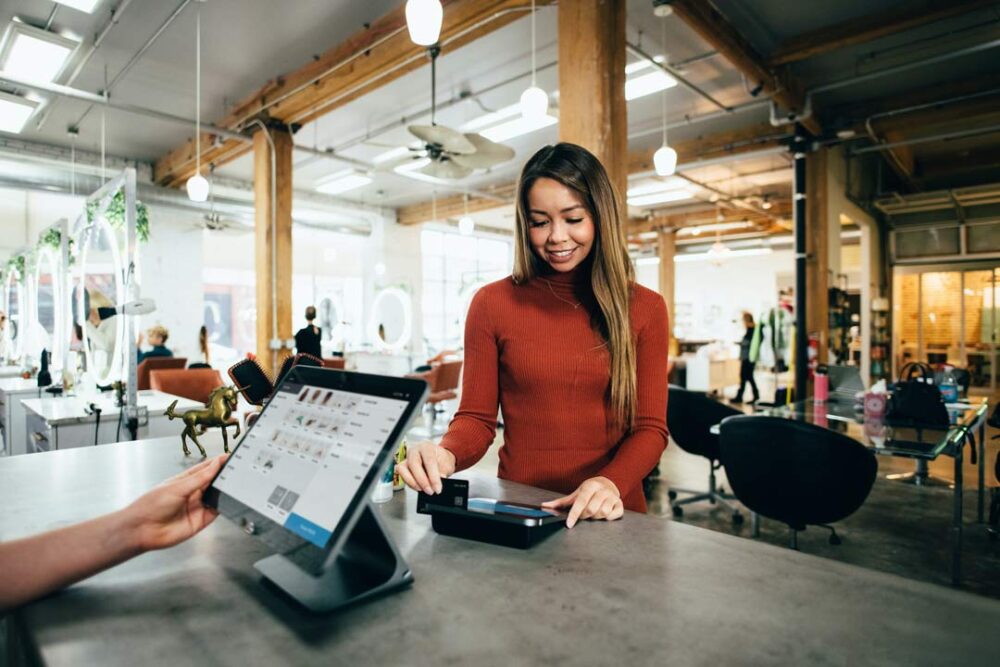Competition in the retail industry is fiercer than ever, making it hard for brands to stand out. In such a landscape, building strong customer loyalty is a necessity for retail businesses, and one of the most effective tactics they should have in their marketing toolkit is loyalty programs.
In fact, according to statistics, about 80% of consumers state they are more likely to stick to a brand that offers a loyalty program. But here’s the thing: it’s no longer enough to just offer it, as that won’t make a big difference, especially if all other brands are doing it— instead, you must get creative and make it as appealing as possible to customers. In this blog, we will dive deep into customer loyalty programs to help you understand how they work and how you can create your own, so read on!

What is a customer loyalty program?
Think of a retail loyalty program as a reward system that provides different incentives to customers (like free offers and discounts) to encourage them to come back. By offering digital apps, or membership cards that enable customers to earn rewards or points when making a purchase, retail businesses can further collect data that helps them refine their marketing strategies. As a result, they can enhance customers’ shopping experience through tailored recommendations and targeted promotions, thus ensuring repeat purchases that help them thrive in a competitive market.
When used correctly, customer loyalty programs can be a game-changer in retail, and Starbucks’ success story is testament to that. The rewards that Starbucks offer to customers set the company apart from competitors – not only it leverages customer data to provide personalised recommendations, but it also makes people feel special on their birthdays by offering them a food item or a free drink of their choice.
Costco, the multibillion dollar global retailer is also a fantastic example of a business that implements customer loyalty programs the right way. The membership format of their business model plays a significant role in their profitability: for the upfront cost that customers pay, they enjoy exclusive perks like private label items and competitive prices. Part of Costco’s success is that the company seeks to maximise clients’ lifetime value to the brand instead of focusing on enhancing profits. And the impacts on customer loyalty are undoubtedly fantastic – Costco has succeeded to grow to 152.7 billion dollars annually. Both brands are incredible case studies when it comes to fostering customer loyalty.
Strategies for success in the retail industry
It isn’t too difficult to enter the retail market – the real challenge is to stay on top of things when other brands are competing with you to draw customers in. So, how can your retail business survive (and thrive) in this industry? Well, in order to ensure that they choose you in favour of another brand, you must adapt continuously to customers’ wants and needs and build a unique experience for them.
If you don’t know where to begin, below we present some strategies to help you set your retail business up for success.
Identify customer’s needs
If you want to meet customers’ expectations, you must first understand what those expectations are. Gathering data about their needs is your starting point when seeking to win them over. Simply put, it’s about identifying their physical and psychological motivations for purchasing a service or product and staying loyal to a brand. Some examples of customer needs involve reliable customer service, friendly agents, transparent pricing, and functional products that help them solve the problems they face. Here’s the thing: you must be willing to go that extra mile for your customers if you want to enhance brand perception. LEGO did just that when they surprised a 11-year old boy with a heartwarming gift: an exclusive Emerald Night Train set. The boy saved cash for two years but could no longer buy the set, as it wasn’t available, so the company tracked it down for him and made a customer happy. Without a doubt, this gave LEGO an advantage and created a strong impression.
In order to meet customers’ needs, however, you must first identify them, and you can do so by using different methods like customer surveys, focus groups, social media listening, and customer journey mapping. All of these tactics can give you valuable insights into the roadblocks that customers face, helping you identify how you can enhance their experience and give them the solutions they are looking for.
Focus on personalisation
Here’s what the statistics say: 80% of customers are more likely to buy from a brand that offers personalised experiences, meaning that you should take advantage of this opportunity if you want to stay relevant. Personalisation allows you to foster customer loyalty by understanding their purchase history, unique preferences, and demographics. Now, personalisation in retail may be more challenging compared to other industries, but it is definitely doable – just make sure that instead of limiting yourself to product recommendations, you curate the entire customer journey.
Amazon, one of Ecommerce leaders, has seen tremendous benefits from implementing a hyper-personalised marketing approach. By utilising customised homepage displays, refined analysis of customers’ purchase history and strategic email marketing campaigns, the company has experienced a substantial increase in its ROI. Amazon also has a recommendation engine that accounts for 35% of the company’s total revenue, and highlights the importance of tailored recommendations in fostering meaningful customer engagement and propelling sales. For instance, let’s say a customer is looking on Amazon’s website for a new smartphone. Thanks to its recommendation engine, the company can gain valuable data into the purchase patterns of the customer, as well as their preferences. Then, the recommendation engine uses this data to present the customer with the latest smartphone that matches their interest.
Choose the right rewards
When seeking to build lasting relationships with customers, it’s essential to take the time to choose the best rewards. There are many loyalty rewards you can use, depending on your budget, and goals. For example, one of the most common is points-based rewards, which enables customers to acquire points every time they make a purchase, write a review about your brand, refer a friend, and so on.
Other ideas on loyalty rewards include free delivery, access to exclusive products, discounts on brand-selected products, one-time events, and so on. When trying to figure out what are the right rewards for your customers, choose something that aligns with their regular purchasing habits – for instance, if you run a coffee business, it makes sense to provide signature drinks as a reward.
Ensure a seamless experience for customers
In a highly competitive market, customer experience remains one of the few ways businesses can set themselves apart from competitors. It’s not difficult to understand the importance of customer experience: if you get things right, you will reap massive benefits, ensuring increased loyalty and, therefore, enhanced sales and business profitability. On the other hand, if you get things wrong, obviously, you could face dire consequences. Obviously, you don’t want to be in the second category, so you should consider following in the footsteps of retail businesses that have set themselves apart through customer engagement. For instance, Bridgestone, which is a renowned tire manufacturer, prioritised building strong relationships with customers offering tailored recommendations, encouraging open communication, and promptly addressing their concerns and needs. The result of the company’s efforts was, of course, enhanced brand loyalty, customer satisfaction, and repeat business.
It’s worth noting the importance of protecting your customers’ data to ensure they will stick with your business for a long time. If you fail to do this, you will immediately lose the reputation you’ve worked so hard to build. Nowadays, it’s easier than ever for customers to understand their rights and take action; for example, they can use a compensation calculator to determine how much compensation they are entitled to for the harm they suffer in case of a data breach. So, if you want your brand to maintain a strong reputation, you should ensure customers are satisfied throughout the entire shopping journey.
Provide quality products/services
Lastly, a significant part of gaining customers’ loyalty comes down to delivering top-notch services and products. Customers’ expectations have changed massively recently, and in order to meet them where they are, retailers should focus on durability, excellence, and reliability, as these are all factors that customers take into consideration in their buying journey. If you think about it, you’ll understand why quality matters so much when looking to earn customers’ loyalty – after all, you wouldn’t want to pay money for something that doesn’t meet your expectations, would you? There are also studies that prove the importance of quality in obtaining repeat business, and ensuring that customers are satisfied with their purchases.
When you focus on delivering quality, you are likely to experience fewer customer complaints, earn the trust of people, and help them connect with your brand on a deeper level. Also, delivering quality fuels recommendations, which means you will attract more customers and therefore, your sales will increase even further, ensuring your retail business remains profitable in the long run.
The benefits of creating an effective customer loyalty program
A customer loyalty program can have significant impacts on your brand, such as:
Higher customer retention rate
In the retail industry, customer retention is a significant challenge, and customer loyalty programs are a game-changer in helping address customer churn. This is because they help build a sense of commitment, ensuring customers won’t explore other alternatives and will stick to your brand instead. If you’ve ever wondered what made Nike build a loyal customer base, the answer lies in the loyalty programs that it offers, which account for over 100 million members that are only growing. The company introduced its loyalty program in 2005, enabling members to access early entry to sales and exclusive products, while also providing them with personalised recommendations. Over the years, however, Nike enhanced the loyalty program by adding extra incentives and benefits, such as free shipping, birthday rewards, and unique events, to name just a few. Later on, the company also included digital features in the loyalty scheme, and this ongoing commitment made a significant difference in shaping a devoted community.
Improved customer experience
A loyalty program naturally enhances customers’ shopping experience, because it shows you care about their needs and desires. When you cater to individuals’ preferences, you create a sense of uniqueness, making customers feel special – and that gives you a significant advantage, helping you build a strong emotional connection with them.
Organic growth via word-of-mouth marketing
In today’s modern world, word-of-mouth marketing still remains one of the biggest tactics you can use to grow your business organically. Simply put, when customers are satisfied with your services or products, they will spread the word about your brand among their family, friends, co-workers, and so on. This is why it is so important to put customers’ experience at the forefront – once you gain their loyalty, they can become powerful brand advocates who talk positively about what you’re doing.
Competitive advantage
Standing out in a crowded retail market takes a lot of work. There are numerous brands customers can choose from, but in the end, they are drawn to those that offer top-notch experiences and personalised interactions. With this in mind, it only makes sense to focus your marketing efforts on building a loyal customer basis, as this will ensure that customers won’t switch to competitors that offer similar services or products. For instance, IKEA has gained a competitive edge in the market thanks to its IKEA Family loyalty program, which comes at no cost, and offers various perks to customers, such as discounts on different products, as well as events and previews of next product ranges.
Different types of loyalty programs in retail
In order to implement a customer loyalty program, you must understand the different types of programs available. It’s essential to take the time to assess all of them so that you can make an informed decision about which one best aligns with your customer’s needs and business goals.
Paid programs
As the name highlights, paid loyalty programs require customers to pay a fee to enjoy the rewards. Now, it may seem like this type of program defeats the general purpose in a way, but that’s not really the case. In fact, this type of program has a huge potential in retaining customers. Not only do they create a sense of community, but they actually increase customer purchases (incredible, right?).
To create a successful paid loyalty program, it’s imperative to offer unique perks that exceed the fee customers pay and ensure they are meaningful and add value to customers’ lives. And, obviously, you should also create top-notch experiences for your customers through a paid program because, in the end, that’s what they are looking for – you don’t expect them to pay just for the sake of it, right?
Points-based loyalty programs
Another method used to enhance customer loyalty is a point-based loyalty program. Simply put, in this program, customers gain points with each purchase they make ( the number of earned points equals the amount spent on products or services). In other words, the more purchases customers make, the more reward points they earn.
These programs aren’t only limited to transactional activities – clients can also earn points for referring friends, engaging on social media, celebrating birthdays, and so on. Points-based loyalty schemes are easy to understand, and they encourage repeat business, thus helping retain customers in the long run.
Tiered programs
Brands in the retail industry widely embrace tiered programs, offering enhanced rewards to customers by considering their level of spending or engagement. A tier is a specific segment in this type of program, where a customer is placed depending on their spending, earning miles, and other indicators that display customer engagement. If a customer advances through the tiers, they can gain access to superior discounts and offers, and extra perks that others cannot benefit from.
This type of program is appealing because it creates a sense of exclusivity, as customers placed in a higher tier feel like they belong to an elite group ( and as a result, they will show an enhanced sense of loyalty to the retail business). Since customers may want to move to the next tier ( or at least keep their current one), they are likely to spend more money on your products or services, thus generating more revenue for your brand.
Subscription-based programs
Subscription-based programs play a significant role in building a strong bond with customers, while also providing a predictable revenue stream for brands. How are they different from the other programs mentioned before? Simply put, customers must pay a fee to access discounts, exclusive products and services. For example, if you run a clothing retail store, you can offer a subscription-based service that enables people to access the latest products early on, a box of curated clothing items on a monthly basis, and so on.
Subscription-based programs are a good option for retail businesses because they increase the likelihood of customers repeating purchases – that’s because they will likely want to take advantage of the benefits that you offer.
Partnered programs
Finally, you can implement a customer loyalty program by partnering strategically with another brand in a similar industry. This approach is suitable especially for retail businesses that want to rely on collaborations to build a large customer base, representing a mutually beneficial arrangement between two brands. For example, such a partnership could happen between a bookstore and a coffee shop, which can join forces to offer freebies or discounts for each purchase that customers make.
This collaboration has immense value, as it helps retail businesses achieve different goals, like gaining exposure to new markets, boosting their brand image, enhancing customer loyalty, and so on.
Final thoughts
Customer loyalty is paramount for the success of any retail business, impacting every aspect of its operations, including revenue generation, repeat business, enhanced retention rate, and positive brand advocacy. To this end, many retail brands are taking advantage of customer loyalty programs to build strong relationships with customers and maximise returns.
Given all the benefits that it provides, it is worth concentrating your efforts on choosing a loyalty program that aligns with your business goals, helping you deliver long-term value and ensuring that competitors won’t lure your customers away. So, are you ready to create a unique loyalty program that provides value, and improve your customer retention rates?
















